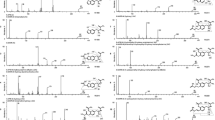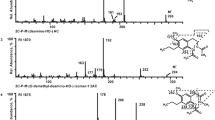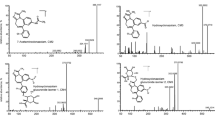Abstract
Designer benzodiazepines (DBZDs) have become of particular importance in the past few years. The metabolite monitoring of DBZD in biological fluids could be of great interest in clinical and forensic toxicology. However, DBZD metabolites are not known or not commercially available. The identification of some DBZD metabolites has been mostly explored by self-administration studies or by in vitro studies followed by high-resolution mass spectrometry. The question arose whether a unit resolution instrument could be efficient enough to allow the identification of DBZD metabolites. In this study, we used an in vitro experiment where eight DBZDs (diclazepam, flubromazepam, etizolam, deschloroetizolam, flubromazolam, nifoxipam, meclonazepam and clonazolam) were incubated with human liver microsomes (HLMs) and metabolite identification was carried out by using a UHPLC coupled to a QTRAP triple quadrupole linear iontrap tandem mass spectrometer system. Post-mortem samples obtained from a real poisoning case, involving deschloroetizolam and diclazepam, were also analysed and discussed. Our study using HLM allowed the identification of 26 metabolites of the 8 DBZDs. These were denitro-, mono- or di-hydroxylated and desmethyl metabolites. In the forensic case, diclazepam was not detected whereas its metabolites (lormetazepam and lorazepam) were present at high concentrations in urine. We also identified hydroxy-deschloroetizolam in urine, while the parent compound was not detected in this matrix. This supports the approach that LC coupled to a simple QTRAP could be used by laboratories to identify other not-known/not-commercialized new psychoactive substance (NPS) metabolites.


Similar content being viewed by others
References
UNODC 2014. World_Drug_Report_2014. World Drug Report United Nations publication Sales No. E.14.XI.7. https://www.unodc.org/documents/data-and-analysis/WDR2014/World_Drug_Report_2014_web.pdf. Accessed 12 Sep 2016
New psychoactive substances in Europe.(2015) An update from the EU Early Warning System | www.emcdda.europa.eu. http://www.emcdda.europa.eu/publications/2015/new-psychoactive-substances. Accessed 13 Sep 2016
Poklis JL, Dempsey SK, Liu K et al (2015) Identification of metabolite biomarkers of the designer hallucinogen 25I-NBOMe in mouse hepatic microsomal preparations and human urine samples associated with clinical intoxication. J Anal Toxicol 39:607–616. doi:10.1093/jat/bkv079
Warner ML, Kaufman NC, Grundmann O (2016) The pharmacology and toxicology of kratom: from traditional herb to drug of abuse. Int J Legal Med 130:127–138. doi:10.1007/s00414-015-1279-y
Forsman M, Nyström I, Roman M et al (2009) Urinary detection times and excretion patterns of flunitrazepam and its metabolites after a single oral dose. J Anal Toxicol 33:491–501
Djezzar S, Questel F, Burin E et al (2009) Chemical submission: results of 4-year French inquiry. Int J Legal Med 123:213–219. doi:10.1007/s00414-008-0291-x
Moosmann B, King LA, Auwärter V (2015) Designer benzodiazepines: a new challenge. World Psychiatry Off J World Psychiatr Assoc WPA 14:248. doi:10.1002/wps.20236
Huppertz LM, Bisel P, Westphal F et al (2015) Characterization of the four designer benzodiazepines clonazolam, deschloroetizolam, flubromazolam, and meclonazepam, and identification of their in vitro metabolites. Forensic Toxicol 33:388–395. doi:10.1007/s11419-015-0277-6
Pettersson Bergstrand M, Helander A, Beck O (2016) Development and application of a multi-component LC–MS/MS method for determination of designer benzodiazepines in urine. J Chromatogr B 1035:104–110. doi:10.1016/j.jchromb.2016.08.047
Pettersson Bergstrand M, Helander A, Hansson T, Beck O (2016) Detectability of designer benzodiazepines in CEDIA, EMIT II plus, HEIA, and KIMS II immunochemical screening assays. Drug Test Anal n/a-n/a. doi:10.1002/dta.2003
Moosmann B, Hutter M, Huppertz LM et al (2013) Characterization of the designer benzodiazepine pyrazolam and its detectability in human serum and urine. Forensic Toxicol 31:263–271. doi:10.1007/s11419-013-0187-4
Moosmann B, Huppertz LM, Hutter M et al (2013) Detection and identification of the designer benzodiazepine flubromazepam and preliminary data on its metabolism and pharmacokinetics. J Mass Spectrom JMS 48:1150–1159. doi:10.1002/jms.3279
Moosmann B, Bisel P, Auwärter V (2014) Characterization of the designer benzodiazepine diclazepam and preliminary data on its metabolism and pharmacokinetics. Drug Test Anal 6:757–763. doi:10.1002/dta.1628
Meyer MR, Bergstrand MP, Helander A, Beck O (2016) Identification of main human urinary metabolites of the designer nitrobenzodiazepines clonazolam, meclonazepam, and nifoxipam by nano-liquid chromatography-high-resolution mass spectrometry for drug testing purposes. Anal Bioanal Chem 408:3571–3591. doi:10.1007/s00216-016-9439-6
Quintela O, Sauvage F-L, Charvier F et al (2006) Liquid chromatography–tandem mass spectrometry for detection of low concentrations of 21 benzodiazepines, metabolites, and analogs in urine: method with forensic applications. Clin Chem 52:1346–1355. doi:10.1373/clinchem.2005.065631
Sauvage F-L, Picard N, Saint-Marcoux F et al (2009) General unknown screening procedure for the characterization of human drug metabolites in forensic toxicology: applications and constraints. J Sep Sci 32:3074–3083. doi:10.1002/jssc.200900092
Sauvage F-L, Saint-Marcoux F, Duretz B et al (2006) Screening of drugs and toxic compounds with liquid chromatography-linear ion trap tandem mass spectrometry. Clin Chem 52:1735–1742. doi:10.1373/clinchem.2006.067116
Saint-Marcoux F, Lachâtre G, Marquet P (2003) Evaluation of an improved general unknown screening procedure using liquid chromatography-electrospray-mass spectrometry by comparison with gas chromatography and high-performance liquid-chromatography—diode array detection. J Am Soc Mass Spectrom 14:14–22. doi:10.1016/S1044-0305(02)00801-2
Nakamae T, Shinozuka T, Sasaki C et al (2008) Case report: etizolam and its major metabolites in two unnatural death cases. Forensic Sci Int 182:e1–e6. doi:10.1016/j.forsciint.2008.08.012
Negrusz A, Moore CM, Stockham TL et al (2000) Elimination of 7-aminoflunitrazepam and flunitrazepam in urine after a single dose of Rohypnol. J Forensic Sci 45:1031–1040
Jones JD, Mogali S, Comer SD (2012) Polydrug abuse: a review of opioid and benzodiazepine combination use. Drug Alcohol Depend 125:8–18. doi:10.1016/j.drugalcdep.2012.07.004
Li AC, Ding J, Jiang X, Denissen J (2009) Two-injection workflow for a liquid chromatography/LTQ-Orbitrap system to complete in vivo biotransformation characterization: demonstration with buspirone metabolite identification. Rapid Commun Mass Spectrom RCM 23:3003–3012. doi:10.1002/rcm.4207
Moosmann B, Bisel P, Franz F et al (2016) Characterization and in vitro phase I microsomal metabolism of designer benzodiazepines—an update comprising adinazolam, cloniprazepam, fonazepam, 3-hydroxyphenazepam, metizolam, and nitrazolam. J Mass Spectrom JMS. doi:10.1002/jms.3840
Author information
Authors and Affiliations
Corresponding author
Rights and permissions
About this article
Cite this article
El Balkhi, S., Chaslot, M., Picard, N. et al. Characterization and identification of eight designer benzodiazepine metabolites by incubation with human liver microsomes and analysis by a triple quadrupole mass spectrometer. Int J Legal Med 131, 979–988 (2017). https://doi.org/10.1007/s00414-017-1541-6
Received:
Accepted:
Published:
Issue Date:
DOI: https://doi.org/10.1007/s00414-017-1541-6




